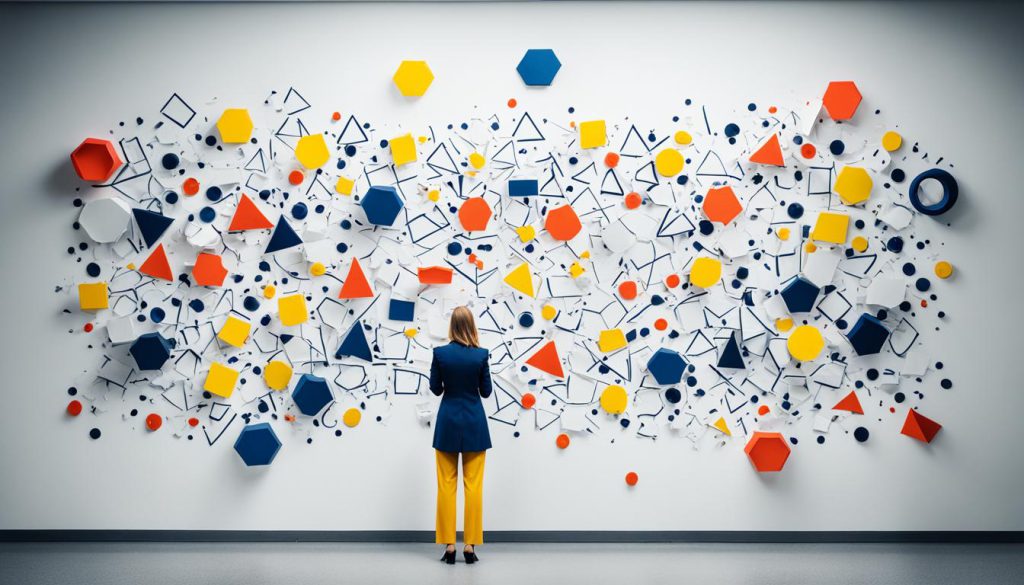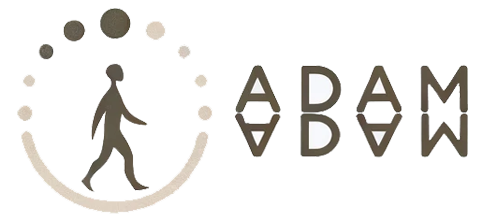Did you know miscommunication costs US businesses about $420 billion every year? Workplace communication issues can really hurt a company’s performance. They affect things like working together, how happy employees are, and how much gets done. It’s important for businesses to spot and tackle these obstacles for a smoother and friendlier workplace.
Key Takeaways:
- Effective communication is key to a good work environment and better relationships among staff.
- Many things can make communication hard at work. This includes language differences, tech problems, cultural gaps, physical barriers, emotional challenges, and how a company is organized.
- To get over these hurdles, it helps to welcome open talks, value diversity, use tech wisely, encourage careful listening, and ease strict company hierarchies.
- Beating communication barriers boosts how well people work together, overall productivity, and the culture at the office.
- Miscommunication costs businesses in the United States an estimated $420 billion annually.
Language Diversity in the Workplace
Communication is key in any successful workplace. But, when employees face language barriers, it’s tough. Different languages or accents can cause mistakes and slow down work.
Global companies often see language difference as a big issue. Being able to talk well across various languages is important for working together seamlessly.
To solve language issues, companies can:
- Offer language support: This means giving language training or classes. It helps employees talk better in different languages. This makes the team more confident and improves how they communicate.
- Use translation tools: Tools or apps for translating languages help people who speak different languages understand each other. They work in real-time, making talking or writing easier.
- Focus on cultural understanding: Teaching everyone to respect different cultures makes the workplace welcoming. It makes people more patient and open when talking to co-workers from other places.
When companies pay attention to language barriers, they can get rid of communication problems. This leads to better teamwork and a happier, more efficient workplace.
Language Diversity Solutions
| Strategies | Description |
|---|---|
| Language support programs | These are ways to offer language training or classes. They improve how employees talk in various languages. |
| Translation tools | These tools or apps help employees who speak different languages talk to each other better. |
| Cultural sensitivity training | This is about teaching the value of understanding and respecting different cultures. It helps create a welcoming work environment. |
Technological Challenges in the Workplace
Technology plays a big role in today’s work settings. It helps us talk and work together easily. But, sometimes tech issues can make talking hard at work. Problems like bad internet, old software, and tools that don’t work together can slow down work and annoy employees.
With more people working from home, these tech problems are even bigger. Remote workers need good tech to talk to team members and do their jobs well. So, it’s important for businesses to fix these tech issues. They should teach employees how to use tech tools right and make sure the tech setup is strong.
Employers can do a few things to fix tech problems at work:
- Upgrade Technology Infrastructure: Getting faster internet and newer software helps make work talk better and fixes tech issues.
- Provide Training and Support: Teaching employees how to use tech tools boosts their tech skills and helps them solve problems.
- Promote Cybersecurity Awareness: Knowing how to keep info safe online is key. Firms should teach workers about this to protect data in digital talks.
- Encourage Backup Plans: Having a plan B for tech issues keeps work going smoothly, even when problems happen.
By tackling tech issues and helping workers with the right tools and training, companies can improve how people talk at work. Better tech communication means more work gets done, teams work well together, and employees are happier.

“Technology is just a tool. In terms of getting the kids working together and motivating them, the teacher is the most important.” – Bill Gates
The Impact of Technology Barriers on Remote Work Challenges
Remote work is more common now. It offers good things like being flexible and better work-life balance. But, it also brings tech challenges.
Bad internet in some places can slow down work and make it hard for remote teams to talk and share ideas. Old software or tools that don’t match can also cause trouble, making people working from home feel frustrated.
To keep remote work smooth, businesses need to fix these tech problems. They need to give remote workers the tech help and training they need. This way, remote work can be more efficient and less challenging.
| Challenges | Impact | Solutions |
|---|---|---|
| Poor Internet Connectivity | – Delays in communication – Decreased productivity – Frustration among remote employees | – Explore alternative internet providers – Invest in Wi-Fi boosters or signal amplifiers – Enable remote team members to visit co-working spaces or public spaces with reliable internet access |
| Outdated Software | – Compatibility issues – Inefficient workflow – Increased instances of errors or system crashes | – Regularly update and maintain software – Conduct compatibility tests before deploying new tools or software – Provide remote employees with up-to-date software licenses |
| Incompatible Communication Tools | – Miscommunication – Difficulty in collaborating on projects – Inefficient exchange of information | – Implement standardized communication tools across the organization – Provide training on how to use these tools effectively – Regularly evaluate and update communication tools based on employee feedback |
Cultural Differences in the Workplace
Cultural barriers can affect how we talk to each other at work. When people come from different places, they act and communicate in ways that can cause confusion. This can lead to misunderstandings.
It’s key to make sure everyone feels their background is important. When workers from various cultures feel respected, they speak up more. They share their ideas without fear.
Teaching about cultural differences is important. Organizations can help people understand each other better by doing this. This creates a workplace where everyone gets along.
Good communication means really listening and considering other viewpoints. It’s about celebrating what makes us different while working together. Finding ways to connect is vital.
“In a world that’s more connected, having a diverse workplace is more than just following laws. It’s about bringing together varied ideas and innovations. This approach lets companies find new solutions and ideas,” says Jane Richards, a diversity expert.
Leadership plays a big role in making everyone feel included. Companies can start groups where workers from similar backgrounds can meet. This makes it easier for people to discuss their experiences.
To help everyone understand each other, businesses might offer translation services. Making sure no one is left out because of the language they speak is essential.
The Benefits of Cross-Cultural Communication
Encouraging people to share their unique views leads to new ideas. It makes solving problems easier by bringing different solutions together. Respect and teamwork grow in this environment.
In today’s global market, talking across cultures is key for success. Companies deal with customers and co-workers from around the world all the time.
A Case Study: Nike’s Commitment to Diversity and Inclusion
| Statistic | Details |
|---|---|
| 1 | Cultural Diversity: Nike has employees from over 100 countries, showing a broad mix of cultures and backgrounds. |
| 2 | Inclusive Leadership: Nike’s leaders aim to make everyone feel important and celebrated for their unique qualities. |
| 3 | Employee Resource Groups: Nike set up groups where workers can connect and help the company grow in a positive way. |
| 4 | Training and Development: Nike teaches employees about cultural differences. This helps them work better together. |

To wrap up, understanding and respecting cultural differences is key in the workplace. By valuing diversity and providing support, companies can remove obstacles. This creates a work environment where everyone contributes and grows together.
Physical Barriers in the Workplace
In busy workplaces, physical barriers can really affect how well people communicate. Things like loud areas, limited technology, and distractions can make it hard for workers to focus, get work done, and work together.
Organizations can make things better by focusing on how the workspace is set up. They can make spaces that make it easy for everyone to talk smoothly. Offering private spots for personal talks helps people feel at ease during important chats. Also, cutting down noise with quiet zones or tech that cancels noise can help everyone concentrate better.
Cutting down noise at work is super important. Loud noises can make people stressed, less able to think clearly, and less productive. By making the workplace quieter with soundproofing, companies can create a calmer space that’s better for talking to each other.
Benefits of a Well-Designed Workspace
A great workspace design is not just about looking good. It’s key to helping people talk well with each other. Here’s what can help:
- Creating spaces specially for teams to work together makes sharing ideas easy and encourages casual talks.
- Comfy and practical furniture makes people feel good physically, which helps them do their best work.
- Bright, well-lit spaces cheer everyone up, make it easier to see, and keep everyone focused.
- Using the right colors can boost creativity and make the workspace a place where people want to be.
By focusing on the design of the workspace and managing noise, companies can knock down physical barriers. This lets everyone communicate better in a supporting environment.
“A well-designed workspace boosts teamwork and cuts down on distractions. This helps everyone talk more openly and get work done more efficiently.” – Workplace Design Expert
| Workspace Design Strategies | Benefits |
|---|---|
| Designated collaboration areas | Encourages open communication and makes impromptu discussions easier |
| Ergonomic furniture | Keeps you feeling physically good and boosts how much you get done |
| Proper lighting | Makes it easier to see and stay focused |
| Thoughtful use of colors | Makes people more creative and productive |
Emotional and Psychological Barriers in the Workplace
Effective communication in the workplace can be blocked by emotional and psychological barriers. Fear and mistrust among workers can lead to a cold environment where communication is difficult. To make the workplace better for teamwork and productivity, it’s key to promote trust and openness.
Building trust starts with creating a culture where everyone feels important and respected. Open communication helps people feel free to share ideas and concerns. When workers feel they are listened to, trust in their leaders and peers grows.
It’s also critical to support a culture where people can safely express feelings and worries. This can lessen fears and break down communication barriers. Team-building activities and supportive leadership can help create this environment, as can resources for mental health.
“Trust and transparency are the foundations of effective communication in the workplace.”
To improve communication, it’s important for organizations to put trust and openness first. Leaders should set an example by being upfront and honest. When leaders share important updates or changes, it builds trust and keeps everyone in the loop.
The Role of Active Listening
Active listening is key to breaking down emotional and psychological barriers at work. It means really paying attention to what someone is saying and showing empathy. This helps employees feel understood and valued, which encourages open communication.
To help with active listening, companies can offer training to their employees. Encouraging active listening makes for a culture where everyone feels okay to speak up. This is important for a good work environment.
The Importance of Conflict Resolution
Workplaces will always have conflicts, but solving these issues right can keep communication smooth. Handling conflicts with respect helps maintain trust. It’s helpful when businesses offer training on solving disputes and have clear policies.
Good conflict resolution keeps communication open. It lets workers share ideas without being scared of backlash. With clear conflict resolution processes, companies can manage the barriers that make communication hard.

In summary, emotional and psychological barriers are tough on workplace communication. But there’s hope. By building a welcoming culture, leading with trust, listening well, and handling conflicts carefully, companies can beat these challenges. This leads to a workplace where everyone can talk openly and work well together.
Organizational Structure in the Workplace
Organizational structure is key in shaping how people talk, share info, and work together at work. If a company’s setup is too rigid or complex, it can slow down how information flows and how well people work together.
In a hierarchical organization, there are clear levels of power. People mostly talk up and down this chain, from boss to worker and back. This setup might make it tough for folks to share thoughts or worries with those at the top.
Making sure there’s an open line of communication is crucial. It helps get past blocks in talking and builds a team-based atmosphere at work.
Breaking Down Silos and Fostering Collaboration
To better share info and ideas, it’s important to get rid of silos between groups. Silos happen when teams don’t share what they know with each other. Encouraging teams to work together can lead to smarter decisions and more creativity.
Leaders can help teams come together. They can set up team activities, projects with people from different areas, or spaces where everyone can meet and mingle. This builds unity.
Open Channels of Communication
Fighting the blocks that come with a strict setup means setting up ways for everyone to talk openly. Having places to give feedback, like suggestion boxes or regular meetings, lets everyone have a say.
Using tech can also help everyone stay in touch and share things easily. Tools like project management apps or chatting apps help people work together and keep info flowing.
Building a culture that’s all about teamwork and open talk can help get rid of power barriers. This creates a place where sharing, team spirit, and new ideas are welcome and everyone feels they can contribute.
Strategies to Overcome Communication Barriers
It’s vital to improve communication in the workplace. By addressing communication barriers, we can make the office more team-oriented and efficient. There are many ways to enhance how we talk and listen to each other.
Promote Open Communication
It’s important to encourage everyone to share their thoughts freely. This builds a culture where speaking up is valued. Use team meetings, suggestion boxes, and forums to boost sharing and teamwork.
Foster a Diverse and Inclusive Workplace
Diversity and inclusion should be our top priorities. An environment that values different views fosters better conversations. By embracing diversity, we encourage honest and open dialogue among everyone.
Use Clear and Concise Language
Good communication needs clear language. Stay away from hard words that confuse people. Instead, use simple words that everyone understands.
Utilize Technology Effectively
Technology helps us connect, especially when we’re far apart. Choose the right tools like video calls, messaging apps, and project software. These help us communicate in real-time, enhancing teamwork.
Encourage Face-to-Face Communication When Possible
In-person talks are very effective. Try to meet face-to-face when you can. This lets us understand each other better, including nonverbal cues, and strengthens our bonds.
Provide Language Support
Language barriers can hinder good communication. Offer programs and services for language learning and translation. This will help everyone communicate better in a diverse team.
Promote Active Listening
Listening is key to good communication. We should listen carefully to each other. By doing so, we understand better and avoid misunderstandings.
Conclusion
Communication barriers can hurt how people work together. They cause misunderstandings, less work done, and sometimes arguments. But, fixing these issues can make the workplace better and more united.
Many things create communication problems at work. These include different languages, tech issues, cultural gaps, and more. Companies need to find ways to deal with these to improve talking between people.
Companies can help by making it easier to talk openly. They can offer language help and use tech wisely. Building trust and being clear also help, as does making everyone feel equal.
To wrap it up, beating communication barriers makes a workspace where everyone feels listened to and important. With the right moves, companies can turn tough communication spots into chances for getting better and winning together.
